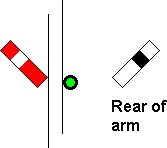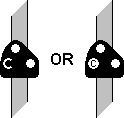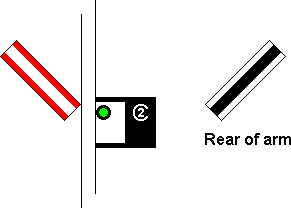|
|
|
|
|
|
|
On the Cheshire Lines Committee, any miniature colour light shunting signal that was associated with a main colour light signal did not display a 'stop' aspect, the red aspect in the main signal providing the 'danger' indication. When the shunting signal was cleared, an illuminated letter "S" was displayed in conjunction with the green light [4.79]. |
|
In 1935, the Southern Railway began providing floodlighted shunting signals [4.80 - 4.83] in colour light signalled areas, which satisfied the recommendation of the Railway Clearing House sub-committee from the previous year. Floodlighted signals present the same appearance to drivers during darkness as they do in daylight.
Around this time, some areas of the LNER were providing illuminated banner shunting signals (see [4.37 & 4.38] and [4.59 & 4.60]) in their power signalling schemes (e.g. Edinburgh Waverley West, October 1936).
|
From around the same time, where a miniature semaphore signal controlled movements from a siding onto a running line in a colour light signalled area on the Southern Railway, it showed a yellow light when cleared [4.84], instead of showing the usual green light. This helped to maintain the principle that a green light should not lead directly to a red signal in a colour light area. |
|
As part of the resignalling between London Waterloo and Hampton Court in May 1936, the Southern Railway installed 'auxiliary running signals' at certain main signals. These were always associated with a main colour light signal and offset to the left or right of it. The positioning of the auxiliary running signal relative to the main signal indicated to which side of the main line the applicable destination lay. Normally a small red light was displayed in the auxiliary running signal [4.85]. When cleared, this was replaced by a small yellow light [4.86], authorising the main signal to be passed for a movement into a goods loop or refuge siding, etc. Where necessary, a signal could be provided with two auxiliary running signals, one to the left and one to the right of the main signal.
Within a matter of weeks, the Southern Railway decided to dispense with the red lights in auxiliary running signals, and thereafter they were normally unlit but still capable of displaying a yellow light when cleared. In a few later installations, an auxiliary running signal was placed below a main colour light signal rather than being offset to one side.
Position light shunting signals were installed under a resignalling scheme at Brunswick (Cheshire Lines Committee) in February 1937. Unlike those signals already in use on the North Eastern Area of the LNER in which the 'stop' aspect was two white lights (see [4.73]), the equivalent aspect shown by the CLC's signals was reinforced by the provision of a red lens in the left-hand light [4.87]. The LNER's North Eastern Area did provide a red light in some position light shunting signals when Leeds New station was resignalled in April 1937, but only at those signals that protected facing trap points or a derailer, where better stopping power was desired. This seemed like a throwback to the practice encouraged by the BoT in 1914, which saw a mix of shunting signals with either red or white lights within the same layout. In any case, the North Eastern Area of the LNER reverted to providing position light signals with all white lights in subsequent resignalling schemes.
The LMS made extensive use of position light shunting signals in its resignalling at Crewe in 1940, and each signal had one coloured lens. Where appropriate, the red lens in the 'on' aspect was replaced by a yellow lens [4.88] to denote that the signal may be passed without being cleared, for a movement in a direction for which the signal when cleared did not apply. Around 1950, British Railways settled on the provision of one coloured lens in the 'on' aspect of all position light shunting signals as standard, and this form of shunting signal was adopted by every region, albeit not by the Southern Region until the early 1960s. The signals with a red lens did have to be operated to display a 'proceed' aspect when facing in the route ahead of a main signal, to prevent drivers from having to pass a red light.
 |
 |
|
[4.87] Position Light Shunting Signal with one Red Light ('on').
Area: All Areas Usage: High Status: Obsolescent |
[4.88] Position Light Shunting Signal with one Yellow Light ('on').
Area: All Areas Usage: High Status: Obsolescent |
|---|
|
On the LMS, the miniature green signal [4.89] was introduced by 1940 as an equivalent to the 'auxiliary running signals' on the Southern Railway (see [4.86]), and these showed a green light when cleared, instead of yellow. |
|
Exceptionally, where a yellow signal at the exit from a siding controlled movements into a block section, the Southern Railway provided a semaphore signal with a full-size yellow arm [4.90 & 4.91].
 |
 |
|
[4.90] Yellow Semaphore Shunting Signal ('on').
Area: Southern Railway Usage: Low Status: Historical |
[4.91] Yellow Semaphore Shunting Signal ('off').
Area: Southern Railway Usage: Low Status: Historical |
|---|
Following nationalisation of the railways in 1948, the Southern Railway's 'auxiliary running signals' (see [4.86]) became a standard feature across all the British Railways regions but were referred to as 'miniature yellow' (or 'small yellow') aspects. Some miniature green signals (see [4.89]) were converted to miniature yellows.
A working party was set up in the late 1950s to examine the differences in signalling practices within British Railways and to recommend standards for use by every region. One of the items agreed in 1960 was that position light signals were the only form of shunting signal to be used inside colour light signalling areas. Position light shunting signals began appearing on the Southern Region as a result, the other regions having already adopted them as standard some years beforehand. Provision of miniature yellow aspects (see [4.86]) was discontinued concurrently in favour of position light signals showing only an 'off' aspect (see [4.74]). Since the practice of co-locating more than one position light signal had ceased around the same time, greater reliance was placed on the use of alphanumeric route indicators (see Section 6) to distinguish between different shunting routes from the same signal.
Outside the Southern Region, a yellow-banded variety of floodlighted disc signal [4.92 & 4.93] was being used in some colour light signalled areas to indicate that the signal could be passed without being cleared, for a movement in a direction for which the signal when cleared did not apply.
 |
 |
|
[4.92] Floodlighted Yellow Disc Shunting Signal ('on').
Area: Various Usage: Medium Status: Historical |
[4.93] Floodlighted Yellow Disc Shunting Signal ('off') ( (a) - lower quadrant type; (b) - upper quadrant type ).
Area: Various Usage: Medium Status: Historical |
|---|
In practice, it was found that floodlighting tended to cause yellow bands on disc signals to merge with their white backgrounds (see [4.92 & 4.93]) during darkness, making them difficult to discern. The yellow-banded disc signals introduced by the Southern Region in the early 1960s had a black background [4.94 & 4.95], which overcame that problem.
 |
 |
|
[4.94] Floodlighted Yellow Disc Shunting Signal with Black Background ('on').
Area: Predominantly Southern Region Usage: High Status: Obsolescent |
[4.95] Floodlighted Yellow Disc Shunting Signal with Black Background ('off') ( (a) - lower quadrant type; (b) - upper quadrant type ).
Area: Predominantly Southern Region Usage: High Status: Obsolescent |
|---|
In November 1961, the S&T Committee agreed to adopt the black background as standard for all yellow disc signals, including those that were not floodlighted and therefore retained the coloured light indications for use during darkness [4.96 & 4.97].
In March 1987, a position light shunting signal at Gresty Lane, Crewe, (London Midland Region) was replaced on a trial basis by an experimental fibre-optic type of shunting signal. The 'on' aspect was a red horizontal bar [4.98], and the 'off' aspect comprised two short white bars inclined at an angle of 45° [4.99]. The experimental signal was replaced by an ordinary position light signal in March 1989.
 |
 |
|
[4.98] Experimental Fibre-Optic Shunting Signal ('on').
Area: Gresty Lane, Crewe Usage: Low Status: Historical |
[4.99] Experimental Fibre-Optic Shunting Signal ('off').
Area: Gresty Lane, Crewe Usage: Low Status: Historical |
|---|
A yellow disc signal installed at the exit from the Down Sidings at Whittlesea (Anglia Region) in November 1988 had a black band on a yellow background [4.100 & 4.101], the reverse of the usual colouring for this kind of signal. It was later changed to have standard colouring.
The position light shunting signals that displayed one coloured light and one white light for the 'on' aspect (see [4.87 & 4.88]) were prone to being inadvertently passed at 'danger' when failure of the coloured light caused a solitary white light to be displayed. A new design of position light signal was introduced from 1996 to overcome this problem. Whilst the 'off' aspect remained unchanged, consisting of two white lights as before (see [4.74]), the new 'on' aspect comprised a pair of coloured lights, both lights being either red [4.102] or yellow [4.103] as appropriate. Note that the 'stop' indication in the signal with two red lights is identical to the standard form of 'limit of shunt' indicator previously introduced in 1985 (see [5.7]).
 |
 |
[4.102] Position Light Shunting Signal ('on').

Area: All Areas Usage: High Status: Current |
[4.103] Yellow Position Light Shunting Signal ('on').

Area: All Areas Usage: Medium Status: Obsolescent |
|---|
Further installations of yellow shunting signals were forbidden from 2002; however, it remains permissible to renew the older style of position light signal (see [4.88]) with one of the new design (see [4.103]), as was done at Littlehampton in March 2003. A position light signal with two yellow lights has also been installed as a replacement for a mechanical yellow shunting signal.
|
|